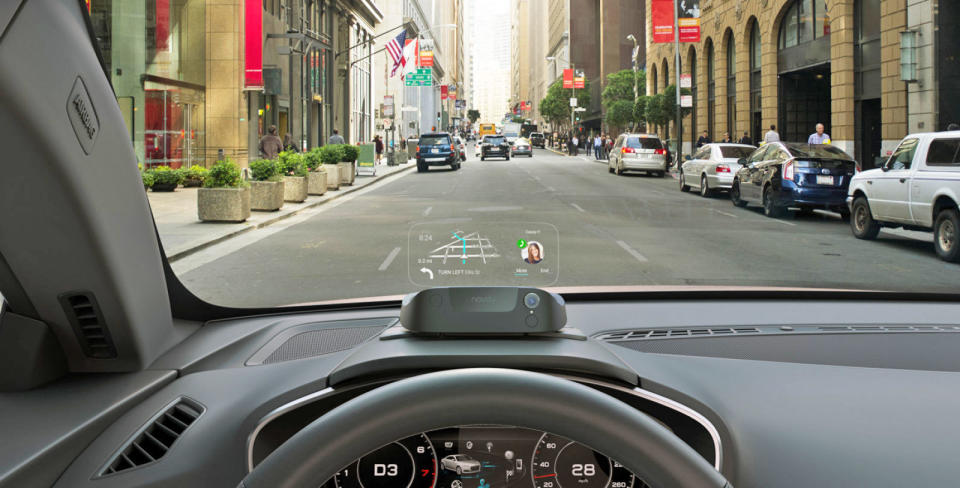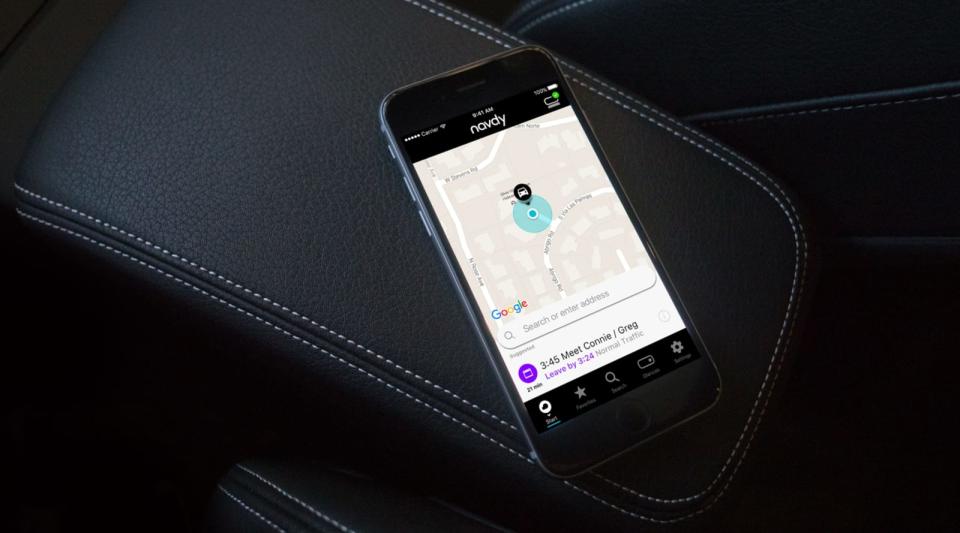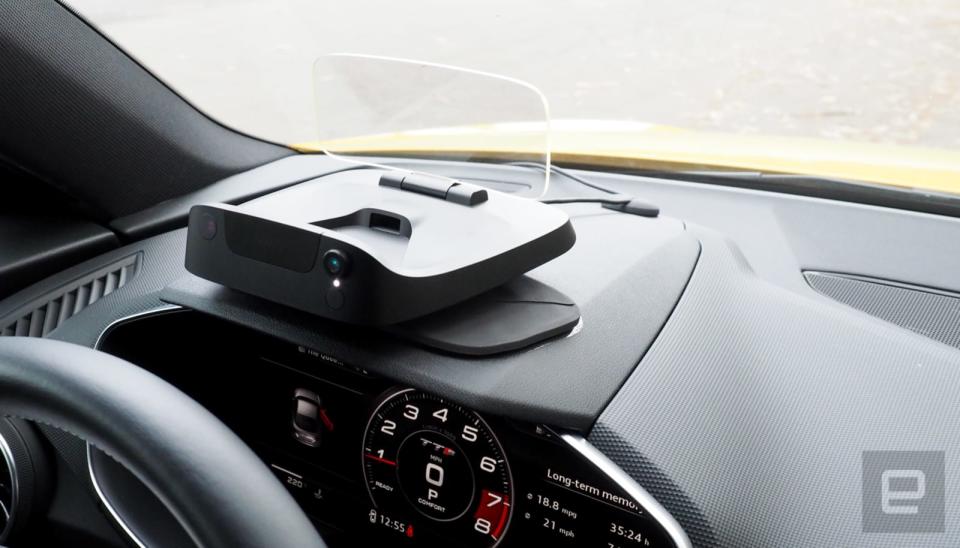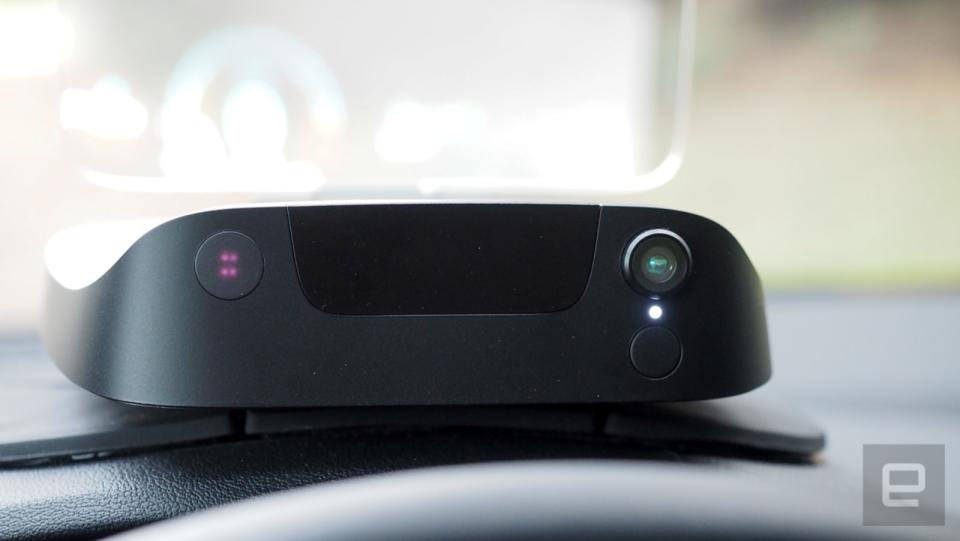The Navdy is an $800 accessory that makes almost any car smart
The third-party heads-up display recently went on sale two years after it was first unveiled.

Not everyone can afford to replace their current whip just to get the latest automotive smart features. The aftermarket world has your back if you want to upgrade your stereo, but if you're looking for an HUD (heads-up display), there aren't a lot of great options. Enter Navdy, a third-party way to make your car smarter with the power of projection. Two years after dropping a slick commercial and crowdfunding campaign, it's finally shipping.
As a refresher, the portable $800 device does more than display your current speed. Via a companion app for iOS and Android, it also has turn-by-turn navigation, music controls, and notifications for messages and calls. Basically, it's a see-through version of your smartphone on top of your dash, and most of the time that's great -- though, as I discovered, there are times when it becomes painfully obvious that it's not a factory-fitted item.
Before even considering the Navdy, you'll have to make sure it'll work with your car, as it requires an OBD II port. That shouldn't be a problem for many people, though, as most vehicles from 1996 and later in the US should have one. If your car fits within these parameters (and, frankly, most will), you're good to go.

And the Navdy is all about going. The full-color HUD display is impressive. Simply flip up its display and adjust it to your viewing angle. It handles direct sunlight and the darkest night without being washed out, but isn't so bright that it burns your retinas. Information is presented clearly, which is what you'd want from something designed to keep your eyes on the road. Even when it's filled with information, you're never distracted from what's ahead of you. By default, Navdy has adjusted the focus range of the display so that the images appear to hover over the hood of a car.
The actual information Navdy serves up varies from helpful to user-enabled overload. The navigation and turn-by-turn directions are great, which, of course, is likely the majority of what you'll do with it. Confusingly, these features are powered by Google search, but use HERE maps. It's odd, but it works well, and that's all that matters. Since Navdy is hooked up to your OBD port for data and power, it also knows how much gas you have and your current speed, meaning this info is also available along with everything mentioned above.

But it's the notifications (Navdy calls them Glances) and how the system handles them that'll make some busy people very happy. Out of the box, it'll show you incoming phone calls and text messages, both of which can be dismissed via the hardware scroll wheel you attach to your steering wheel or hand gesture should you choose to focus on the road. You can also configure Navdy to just read text aloud, display the text only, or do both. I used both audio and visual cues during my test, and it worked brilliantly.
I foolishly thought I'd try activating many more notifications, including Slack, email, Facebook, WhatsApp, Twitter and Facebook Messenger. The result was mental overload and a reminder that even if you're looking at the road, too much mental distraction is incredibly dangerous.

While some will appreciate the inclusion of hand gestures (swipe right to answer, left to ignore), most will stick to the dial that attaches to the steering wheel for navigating menus and controlling music. It's much easier to spin the dial and click with your thumb than swat in the air. If you prefer voice commands, you can access Google Assistant or Siri with a long press of the central button. Using those voice-powered helpers to find and play music, place calls and reply to messages makes for a futuristic-feeling marriage of car display and smartphone features.
It's worth noting, though, you can't use voice commands to invoke either Google or Apple's own map apps for navigation. Instead, you have to use the mapping software within the Navdy companion application, and that means no voice-powered address search. You can add favorite locations to the app that will appear in the display, but if you need to head to a new location while driving, you'll need a passenger to enter it into your phone, or pull over and manually do it yourself.
This lack of support for other mapping apps is probably the system's Achilles' heel. While Navdy offers a safer way to interact with navigation, music and ongoing routing, it's a shame drivers have to unlock a phone simply to add a new address. In fact the system is so tied to its own app that it has to be running just to turn on the Navdy. It's a minor annoyance (and, fortunately, the display will prompt you via your smartphone to launch the app) but much like launching like Spotify for music, launching the app will become second nature after using the device for a few journeys.

I was initially concerned that making Navdy portable and removable would be another inconvenience. Who wants to drag a piece of tech out to the car every time they drive? But like launching apps, placing the device on its magnetic dock became second nature.
As for installing the base? Navdy says folks will be able to do it in about 15 minutes. For those who don't want to get their hands dirty, the company has teamed up with Enjoy to offer same-day delivery and installation in a number of major cities (Los Angeles, Chicago, New York, Dallas, Houston, Atlanta, Miami and the San Francisco Bay area). The removable Navdy device uses magnets to connect to the base unit. This seems like it'd be a bad idea, but during my drives (which included multiple trips through a kidney-jarring construction zone) the Navdy never came loose.

If rough roads are where you clock up most of your miles, or if you have a vehicle with harder than usual suspension (for example, a sports car), Navdy's HUD display is probably not ideal. No matter how well it's mounted to the dash, the display is prone to vibrations in any less-than-ideal road conditions.
I tested the system in an Audi TT on San Francisco's perpetually under-construction avenues. On a road near my house that's been under construction for what seems like years, trying to read the display while it vibrated resulted in a headache, even in the Audi's "comfort" suspension mode. Throw in potholes, ruts and ignored infrastructure, and you have a recipe for frustration. If your car's suspension isn't tuned for cornering you should be fine, but you might want to take note of the condition of your usual driving routes before dropping $800 on a heads up display.
Despite its minor flaws, the Navdy is a solid product that adds functionality I didn't even realize I wanted. On a few occasions I jumped into the car and started driving without placing it on the dash and instantly missed it.
On one trip, I drove down an unfamiliar street at night and realized it would be easier and safer if I pulled over and dropped Navdy on the dash instead of continuing to glance down at my phone for directions. With the HUD in place, I have great, visible navigation and can leave the phone in the glove compartment. The allure of constantly being connected means I haven't done that in years. For the record, I don't text, tweet or Facebook and drive, but having the phone nearby just in case has been my excuse for keeping it handy. Navdy erased that need and made my driving that much safer.











